Who knew STEM and, specifically, physics could be so much fun? We did! Want to learn how to make a simple catapult with popsicle sticks? This popsicle stick catapult design is an AWESOME STEM activity for kids of all ages! Get the step by step instructions to make a simple catapult out of popsicle sticks and learn all about how a catapult works. Your kids will be flinging objects in no time!
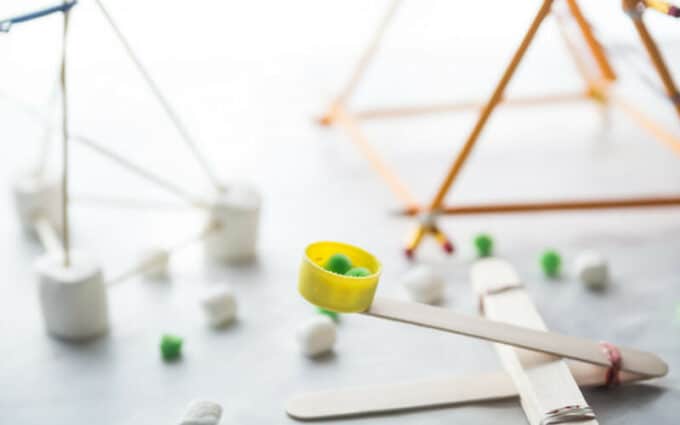
How To Make A Popsicle Stick Catapult
VARIATION: You can also make a popsicle stick catapult with a spoon which is especially great for holding objects like plastic Easter eggs or fake eyeballs.
Supplies:
- 10 Jumbo Popsicle Sticks
- Rubber Bands
- Firing Power (marshmallows, pompoms, pencil top erasers)
- Plastic Spoon (optional
- Bottle Cap
- Sticky Dots
Watch the Catapult Making Video!
Free Printable Catapult STEM Worksheet
Log your results with this free printable science worksheet for your catapult activity and add it to a science journal!
Instructions:
STEP 1: Make predictions. Which object will fly the farthest? Why do you think one will fly farther than the other?
STEP 2: Hand out supplies to each individual or in small groups, and build a Popsicle stick catapult following the instructions below.
STEP 3: Test and measure each item’s length when flung from the catapult—record your results.
Make sure to download and print the catapult worksheet below to record your results.

STEP 4: You will want to use a pair of scissors to make two v notches on either side of two jumbo craft or Popsicle sticks (in the same place on both sticks). Use the photo below as a guide for where to make your notches.
Adults: This is a great step to prep ahead of time if you are making these popsicle stick catapults with a large group of kids.
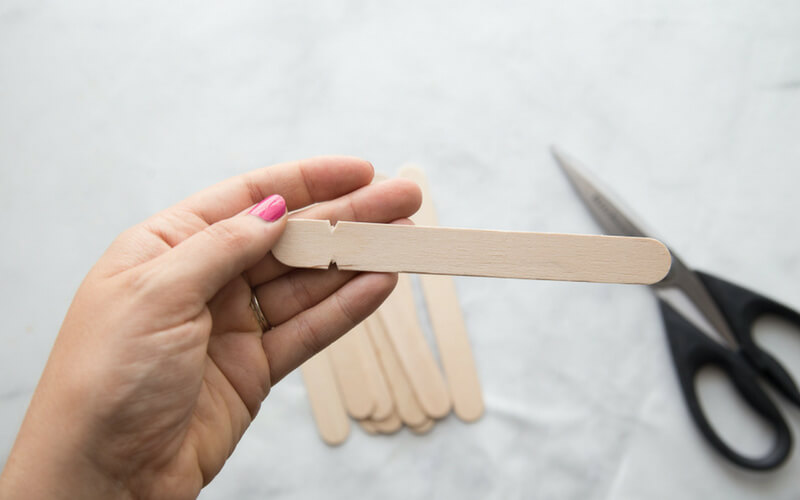
Once you have made your notches in two of the sticks, set them aside!
STEP 5: Take the remaining 8 craft sticks and stack them one on top of the other. Wind a rubber band tightly around each end of the stack.
STEP 6: Go ahead and push one of the notched sticks through the stack under the top stick of the stack. Make sure to watch the video again to see this done.
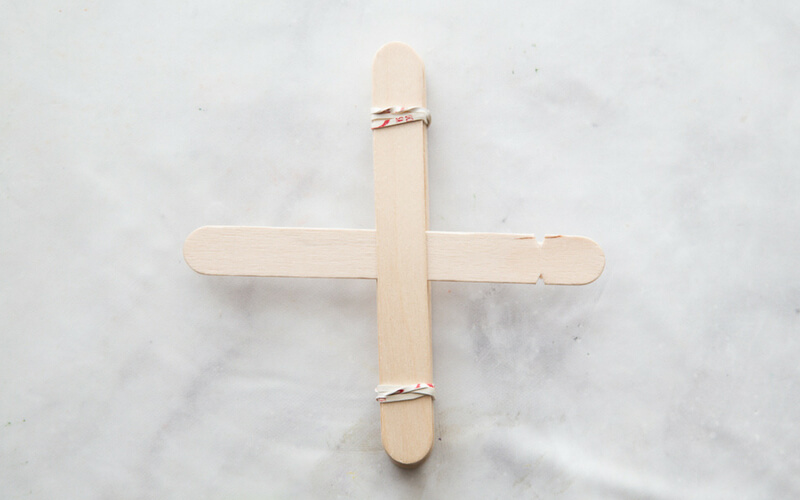
At this point flip your partially made popsicle stick catapult over so that the stick you just pushed in is on the bottom of the stack.
STEP 7: Lay the second notched stick on top of the stack and secure the two popsicle sticks together with a rubber band as shown below. The V notches that you cut help to keep the rubber band in place.
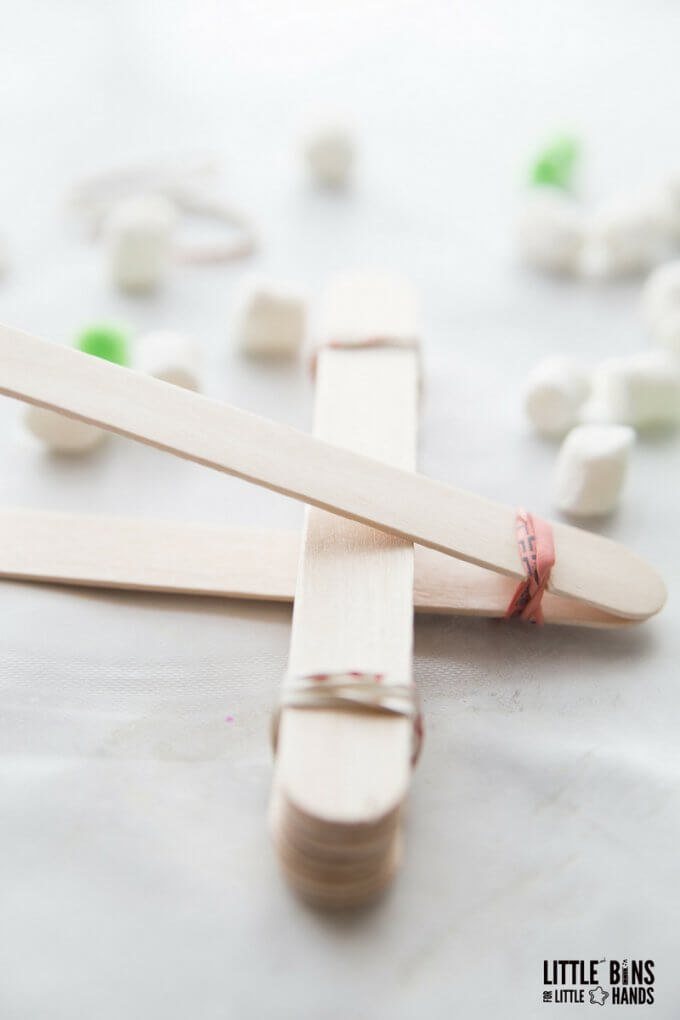
Create more leverage with your catapult by pushing the stack of popsicle sticks towards the notched ends connected by the rubber band. Make sure to read about the science behind this too!
STEP 8: Attach a bottle cap to the popsicle stick with sticky dots or strong adhesive. Get ready to fire away!
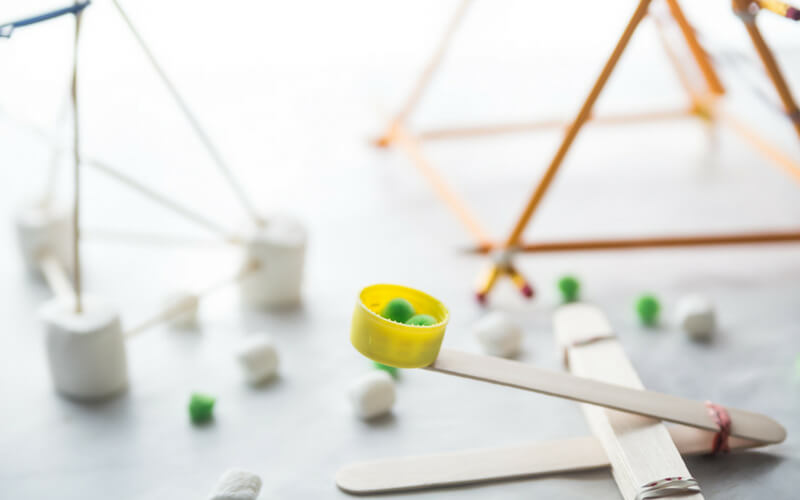
Catapult Building and STEM
These Popsicle stick catapults make a great STEM activity! Building a catapult involves understanding basic science concepts such as force, motion, and energy transfer. Learn more about how a catapult works below.
Creating a popsicle stick catapult uses technology as it involves designing a simple machine. Kids explore the mechanical aspects of how levers work and how the components of the catapult interact to achieve a specific function.
Designing and building a functional catapult requires problem-solving skills which is the engineering component. Kids must consider factors like stability, tension in the rubber band, and the angle of launch to optimize the catapult’s performance.
Kids use mathematical concepts to measure and cut popsicle sticks accurately. They also explore geometric principles when determining the launch angle and trajectory of the projectile.
Putting It All Together…
Kids can experiment with different designs, sizes, and materials to optimize the catapult’s performance. This process involves testing, data collection, and analysis to find the most effective design.
After launching the projectiles, kids can measure and record the launch distances at different angles or with different weights. Analyzing the data allows them to draw conclusions about how changes in the design or launch parameters affect performance.
Integrating technology, participants can use tools like rulers, protractors, or even digital devices to enhance the accuracy of their measurements and record observations.
Discuss real-world applications of catapult technology, such as historical siege engines or modern devices used in engineering and physics research.
By building a popsicle stick catapult, participants engage in a hands-on STEM activity that not only fosters creativity and teamwork but also provides a practical application of scientific and engineering principles. This type of project encourages critical thinking, experimentation, and the application of knowledge to solve a problem — all essential components of STEM education.
How Do Catapults Work?
This is a great simple physics activity for kids of multiple ages. What is there to explore that has to do with physics? Let’s start with energy including elastic potential energy. You can also learn about projectile motion.
Newton’s 3 Laws of Motion state that an object at rest stays at rest until a force is applied, and an object stays in motion until something creates an imbalance. Every action causes a reaction.
When you pull down the lever arm all that potential energy gets stored up! Release it and that potential energy gradually changes over to kinetic energy. Gravity also does its part as it pulls the object back down to the ground.
Learn more about potential and kinetic energy.
You can talk about stored energy or potential elastic energy as you pull back on the Popsicle stick, bending it. When you release the stick, all that potential energy is released into energy in motion producing the projectile motion.
A catapult is a simple machine that has been around for ages. Have your kids dig up a little history and research when the first catapults were invented and used! Hint; check out the 17th century!
Turn It Into A Science Project
Here are several ideas for how to turn this fun catapult building activity into an experiment.
1. Launch Distance vs. Launch Angle
Explore how changing the launch angle of the catapult affects the distance the projectile travels. Set up targets at different distances and experiment with various launch angles. Measure and record the distances to analyze the results.
2. Projectile Weight and Distance
Test how the weight of the projectile influences the launch distance. Use different objects as projectiles (e.g., cotton balls, small balls of clay, or paper wads) and compare their launch distances. Discuss the concept of mass and its impact on motion.
3. Rubber Band Tension
Investigate how adjusting the tension in the rubber band of the catapult affects its performance. Experiment with different rubber band lengths or thicknesses to observe changes in launch distance and speed.
4. Projectile Shape
Test how the shape of the projectile affects its flight. Use projectiles with different shapes (e.g., spheres, cylinders, or irregular shapes) and observe how each type performs in terms of accuracy and distance.
5. Aim and Accuracy
Set up a target and experiment with aiming techniques. Investigate how changes in launch angle and force affect the accuracy of hitting the target. Discuss factors influencing accuracy, such as wind resistance.
6. Rubber Band Material
Test different types of rubber bands (thick, thin, natural rubber, synthetic rubber) to observe how the material affects the catapult’s performance. Discuss the elasticity of different materials and their impact on launching.
7. Catapult Materials
Experiment with building catapults using different materials (e.g., popsicle sticks, plastic spoons, or craft sticks). Compare their strength, flexibility, and overall performance.
Encourage kids to record their observations, measurements, and conclusions. Learn more about using the scientific method with kids, making observations and choosing variables.
Catapult Building For Middle School
Here are 3 tips for using this catapult activity with older students.
1. Emphasize the Engineering Design Process
Encourage students to follow the engineering design process, which typically includes stages such as defining the problem, researching, brainstorming, designing, building, testing, and iterating.
2. Encourage Experimentation
Foster a culture of experimentation. Encourage students to try different designs, materials, or adjustments to improve their catapult’s performance. Emphasize that failure is a natural part of the process and can lead to valuable insights. By working on their designs, students learn to refine and optimize their creations.
3. Incorporate Measurement and Analysis
Integrate mathematical concepts by incorporating measurement and data analysis into the project. Have students measure launch distances, angles, and other relevant parameters. Discuss the importance of accurate measurements and guide them in analyzing the collected data.
Additionally, consider incorporating a competitive or collaborative element to make the project more engaging. For example, you could organize a catapult competition where students compete to launch projectiles the farthest or hit a target accurately. This adds an element of excitement and motivation for the students.
The Challenge: Make a catapult that will launch a ping pong ball from one end of the table to another while clearing an obstacle.
Remember to emphasize the connections between the project and real-world applications of engineering, physics, and technology. Discuss historical catapults, their uses, and how modern engineering principles relate to the simple machines employed in a catapult design.
Our Results
His first design would not launch more than a foot on average. Of course, we took multiple test runs and wrote down the distances! His improvements launched the ball way off the table and more than 72″. Is it Pinterest-worthy? Not really. However, it’s the work of a junior engineer who solves a problem!
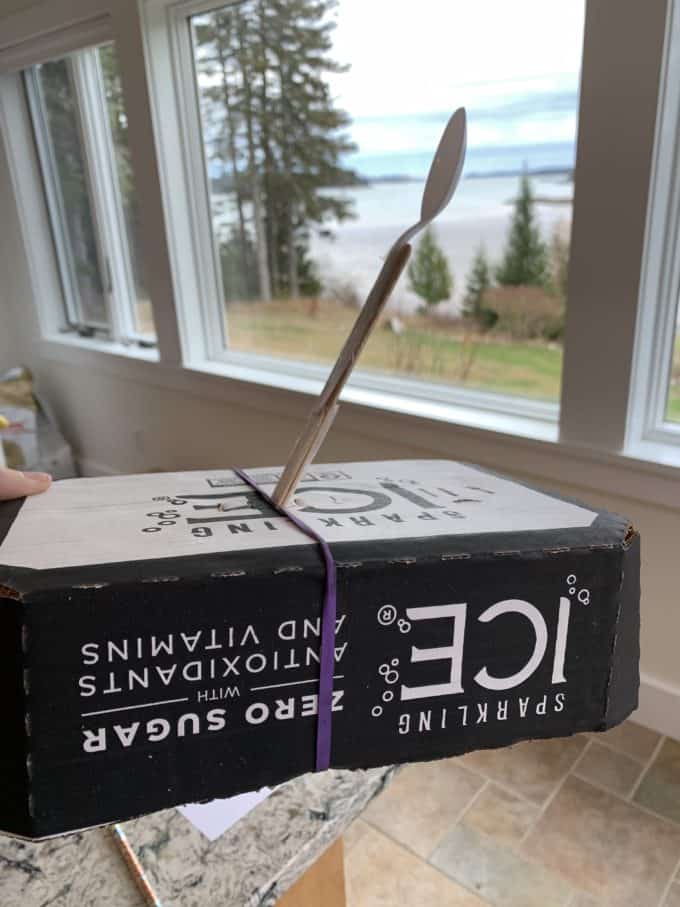
More Catapult Design Ideas to Try!
Explore how catapults work with other design ideas, including:
- LEGO catapult
- Jumbo marshmallow catapult.
- Pencil catapult with a handful of school supplies
- Spoon catapult with excellent firing power!
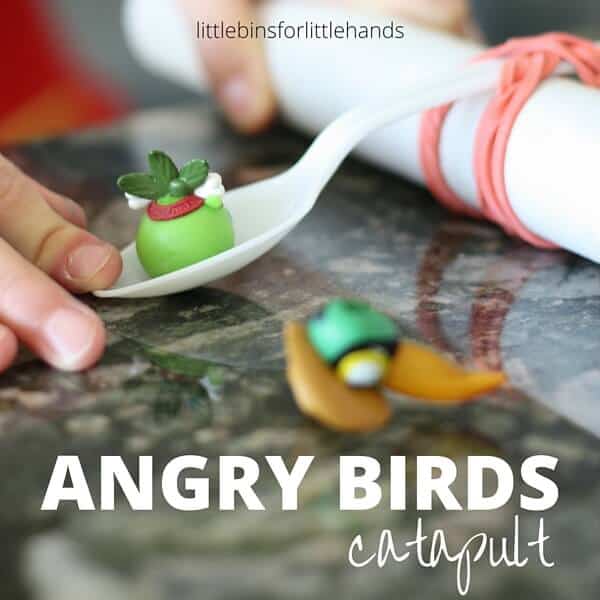

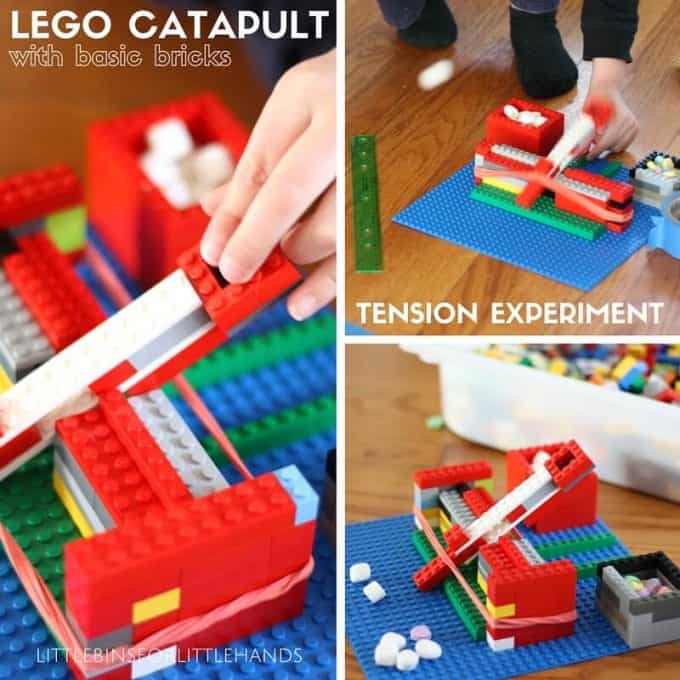
Fun Holiday Theme Catapults To Make
Why not make one of these fun theme catapults, with flinging hearts to candy to jingle bells and more.
- Halloween Catapult (Halloween Candy)
- Christmas Catapult (Jingle Bell Blitz)
- Valentine’s Day Catapult (Flinging Hearts)
- St. Patrick’s Day Catapult (Lucky Leprechaun)
- Easter Catapult (Flying Eggs)
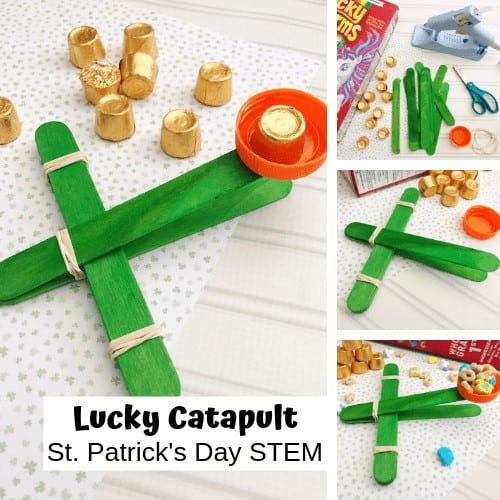
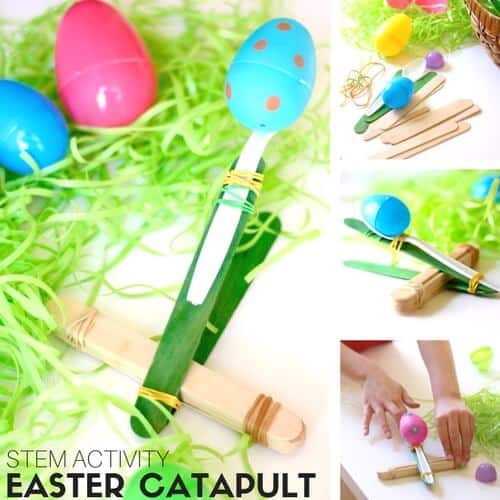
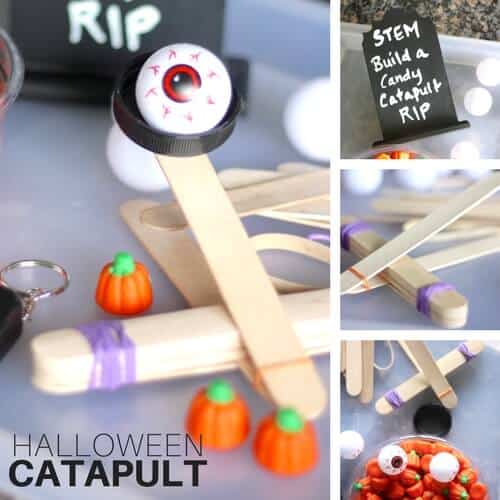
STEM Resources To Get You Started
Here are a few resources that will help you introduce STEM more effectively to your kiddos or students and feel confident yourself when presenting materials. You’ll find helpful free printables throughout.
- Engineering Design Process Explained
- What Is An Engineer?
- Engineering Words
- Real World STEM
- Questions for Reflection (get them talking about it!)
- BEST STEM Books for Kids
- 14 Engineering Books for Kids
- Jr. Engineer Challenge Calendar (Free)
- Must Have STEM Supplies List
- Join us in the Club
Printable STEM Project Pack For Kids
80+ Doable Engineering Projects in one convenient pack!
- Full instructions with sample images
- Activity-specific instruction sheets
- Data Collection Sheets
- Questions for Reflection
- Architecture Building Cards: Try the tallest tower challenge
- Bridge Building Cards: Explore different types of bridges to build your own.
- Paper Chain STEM Challenge: Who can make the longest chain? Great icebreaker or quick challenge!
- 3 Little Pigs Architectural Pack: Design a house that won’t blow away!
- Great marshmallow challenge: A classic challenge kids love!
- Real-world STEM challenge lesson but don’t know where to start? Our easy-to-follow template shows the steps!
- What’s the difference between a scientist and an engineer?
- Crossword and word search with engineering vocabulary.
- Engineering vocabulary cards
- Design a one-of-a-kind invention and write about it with this 5-page activity!
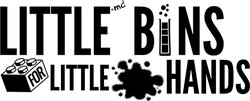

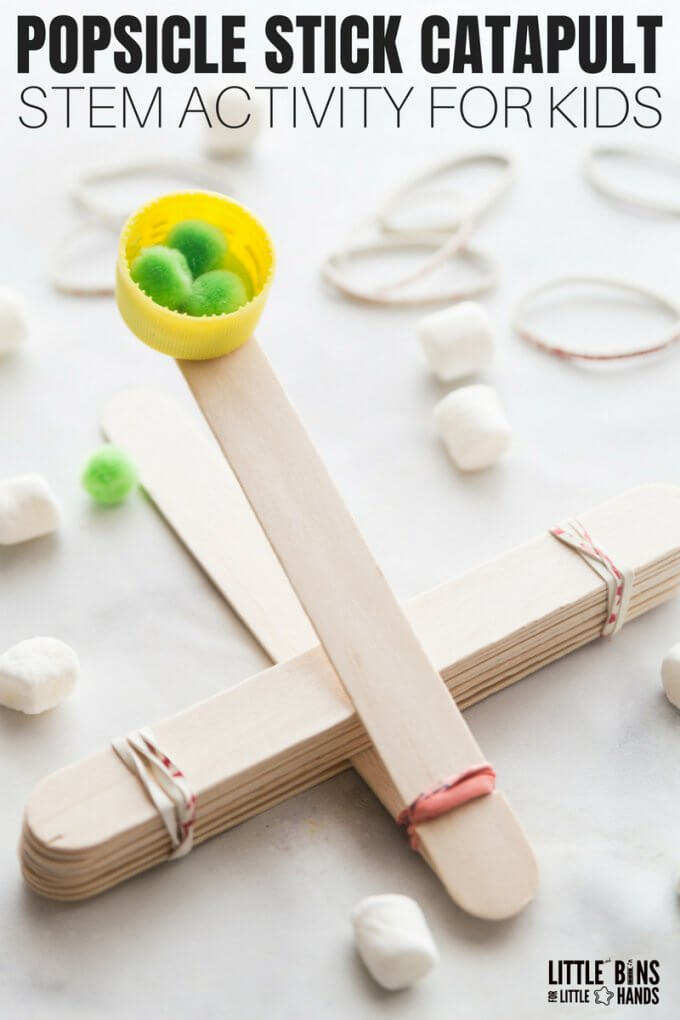
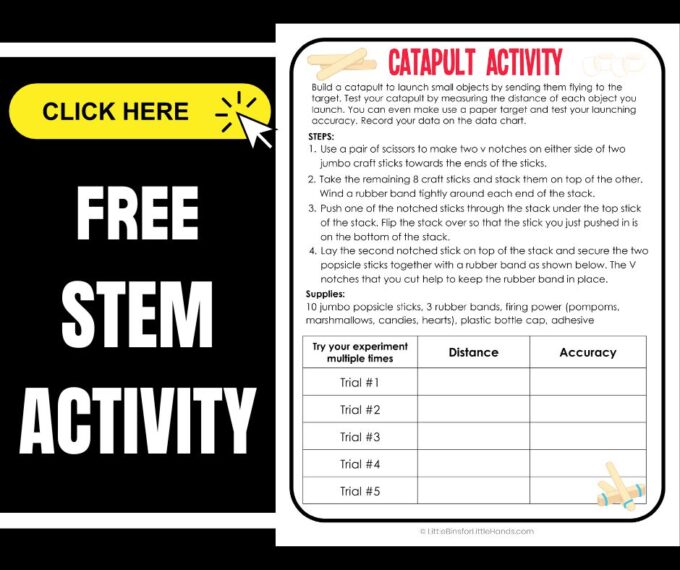

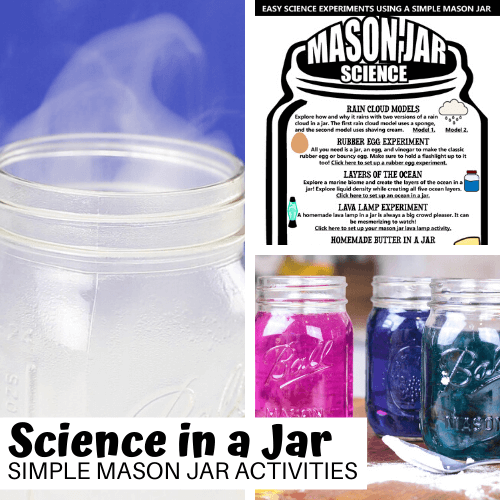
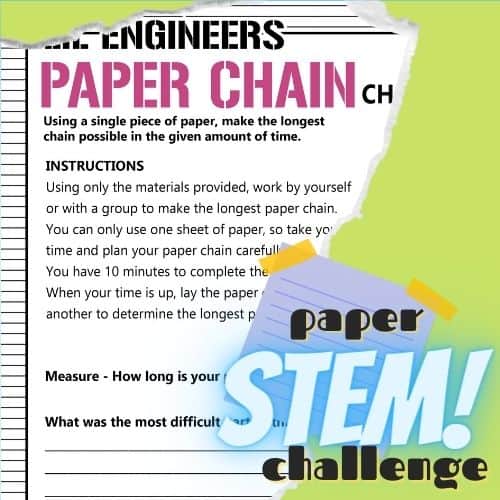
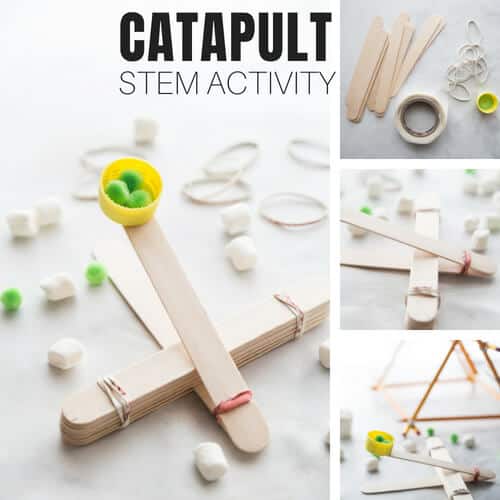
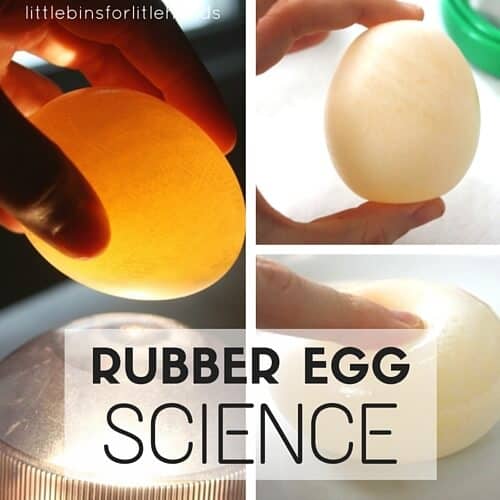
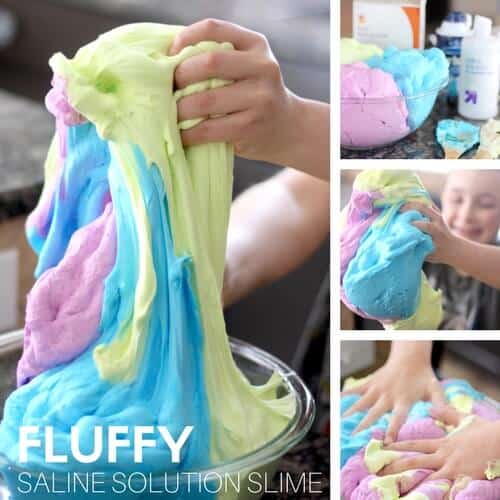

How fun! I know Caden would love making and playing with one of these!
Thanks! I needed a really simple idea that the kids can replicate at home. So much fun teaching science. They find all kinds of ways to change things and predict what will happen. This is real life!
I got an F on this
Sorry 🙁
This is a mindless activity that does not help kids grow or learn.
That’s too bad you feel that way. I think it’s great for testing predictions with different weighted objects. It makes a great screen free activity where kids can design and engineer their own catapults from their own designs.
I have taught this lesson many times in middle school gifted classes. Its more about teaching collaboration and the engineering design process. Hold the students accountable to recording their data and iterations. Its good science regardless of what others might believe.
Thank you! It is really what you make of it and what you extend to your kids. The older kids get the more involved the catapults can become with more elaborate data collections and challenges.
This activity was amazing for my kids!!
All the tricks are good, simple and affordable.
That’s not true. STEM incorporates Science, Technology, Engineering and Maths. The children will, without realising, be developing all of these skills plus language, communication and teamwork skills if they are working with a partner/ parent.
Very true! Just because something looks really simple and kids are playing, doesn’t mean it isn’t full of learning possibilities.
I was wondering if anyone knows how to build a catapult out of pvc pipe and if so then can i get any advicwe on how to build one
We do have one out of PVC pipe that you can check out here: https://littlebinsforlittlehands.com/egg-launchers-easter-science-activities/
Hi! I have a question, in the directions it talks about watching a video and I can’t seem to find a video anywhere, can someone direct me to one? 🙂 im really excited to do this with the kids at my work!
It should be towards the top!
made one with a freind,messed up he wanted it and he likes it a lot.
I love it! It didn’t work on the first try, but then it was awesome! thanks for the instructions!